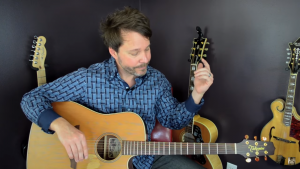Having been a professional guitar player and teacher for over 30 years now, I have seen many techniques, courses and tips from a variety of teachers and schools. Many of them were good, a few great and some just plain bad.
A student recently asked me what I thought were the top five things that every beginning guitar player must know. Dozens of skills, techniques and lessons immediately came to mind, but I really wanted to narrow it down to five subjects only. Here is where my 30-plus years of playing and teaching, thousands of one-on-one lessons with my students, hundreds of instructional videos, numerous lessons with other teachers, and three books have led me.
These are in order of how a guitarist might experience the guitar from day one:
1. Fretting Technique
Editor’s note: The videos in this article are selected from different series created by the author, Erich Andreas. Some are from the middle of their series, but they should make sense alone even if you’re a beginning guitar player.
Every guitar player since the dawn of man has needed to develop their fretting technique. There is not a guitarist alive who should not have fretting, from the very basics to advanced slurs, at the forefront of their routine. After all, it’s how we change notes and chords.
Whether you are practicing dexterity exercises or just playing your favourite songs, the more you do, the better you get! In fact, it’s impossible for you to not get better if you are fretting.
I always tell my students to always have a guitar in their hands. Make sure that when you are watching T.V., you are practicing scales or doing dexterity exercises. The more the better! And don’t forget about that pinky.
‘There is not a guitarist alive who should not have fretting, from the very basics to advanced slurs, at the forefront of their routine.’
For newbies: Your hand is not too small. Every guitar player thinks that in the beginning. Once you have your basic fretting down, you won’t think that any longer.
Whether you are a newbie or advanced player, the following tips for better fretting will quicken your movements, reduce fatigue and clean up your sound.
Pick frets 1, 2, 3 and 4 on the high E string and then move to the other strings. Slow and steady wins the race on this!
- Play on your fingertips, not on the pads of your fingers.
- Play right behind the fret wire, not further back (which creates buzzing/muting) or on the fret wire (which mutes the guitar string).
- Get accustomed to curling the knuckle that’s closest to the fingertip. This will help with chords later on.
- Having a small amount of space between the webbing of your palm and the guitar neck will help with your technique. Don’t grab the guitar neck like it’s a shovel handle. It’s not …
2. Picking Technique
I try to separate all guitar skills into three areas: fretting, picking and theory (next on the list below).
Picking, be it picking with a plectrum (pick) or fingerpicking, is as crucial as fretting. Both techniques should be practiced separately from each other at first.
Once they start feeling natural to the beginner, combining the two is the next step. Of course, this is where most guitarists run into a bit of trouble as the synchronization of the two does take some time to feel natural.
I first prescribe the ‘pick rest’ technique. To do this basic but often overlooked technique, pick a single string and rest the pick on the string below the one you just picked.
‘Picking … is as crucial as fretting. … Once they start feeling natural to the beginner, combining the two is the next step.’
Don’t let the pick ‘float’ above the strings. Allow it to rest on the string below each time.
Do this for single strings (6, 5, 4, 3 and 2). Then, do this for two strings at a time, then 3, then 4, etc.
Once that basic but often overlooked technique is mastered, it’s time to sync both hands up with some dexterity exercises, scales and chords. Slow and steady wins the race every time when it comes to syncing these two up.
It seems the ‘kiss of death’ for guitar players is when they try to rush this process. I always say, ‘accuracy leads to speed’. You will never be fast before being accurate. Always think accuracy. Speed will happen as a byproduct of accuracy.
3. At least some basic guitar theory knowledge
Music theory is essentially the study of ‘how music works’. Every guitar player should know some basic music theory. The more you know, the better you are able to navigate the fretboard, and since the fretboard is the guitarist’s domain, it would make sense to understand the landscape.
I have heard many guitarists (typically lazy guitarists who are not very good) say that their favourite guitarist never learned music theory and that they did everything by ear. Listen, any 14-year-old can get in a car and drive around. However, pressing the gas pedal and moving the steering wheel back and forth does not make a great driver! Ask my grandmother!
We all know that getting by and excelling at something are two totally different things. So, are you that guitarist who thinks you are so inspired that you ‘don’t need that crap’? Get in line, my friend! Every musician since the beginning of time has had this thought at least once.
‘Every guitar player should know some basic music theory. The more you know, the better …’
But then … you get a piece of theory knowledge and you see how powerful it is (like moving the same scale up and down the fretboard). Then that compounds with another piece of knowledge (like barre chords or the CAGED system). Then all of a sudden you are twice the player you were before, not because you played more but because you added to your knowledge.
The first place to start is to know the notes on the fretboard. This is easy! The strings from the low E to the high E are E, A, D, G, B, E, and an easy way to remember this is:
Eddie
Ate
Dynamite
Good
Bye
Eddie
Now, you will never forget this word picture! Add these next two bits of info and you have the fretboard memorized:
- The musical alphabet goes A–G.
- All notes have sharps, except for B and E.
So, with that being said, the low E string played from the open string to the 12 fret would be:
E, F, F#, G, G#, A, A#, B, C, C#, D, D#, E
Note that E went straight to F and B went straight to C. See rule two above for why that is.
Now, do this for the other strings, starting with the open string names from our word picture.
If you get stuck, see the chart below:
And it should go without saying, kids, please don’t eat dynamite … 🙂
4. Direction / Practice Schedule
What is it that you want to do on the guitar?
This is one of the most important questions you can ask yourself, because the answer will directly determine what you should be practicing/playing, which will make your learning curve less steep. No need in learning a bunch of scales if you don’t want to play lead. No need in learning jazz chords if your love of punk music is insatiable.
‘… the quickest way from A to B is a straight line. Determine what you want from the guitar, and practice those things feverishly!’
That’s not to say that you should not stretch yourself, but the quickest way from A to B is a straight line. Determine what you want from the guitar, and practice those things feverishly!
Sometimes knowing what not to play helps you to determine what to play. So, what do you want to do with the guitar? Answering this question, at least in your own mind, will help the way you practice and will cut out anything that is wasting your time. Do it!
5. Resources
Do you have a teacher? Are you taking a guitar course? Are you a newbie and need something to get you started?
You must have something to inspire you to keep you going. For some it’s a constant stream of new songs, for some it’s a great instructor or another guitarist. Whatever it is, you must have a great resource for learning guitar.
With the internet now, it seems that there are a lot of resources, from tabs to YouTube. Whatever is your source of inspiration, remember A.B.L.! Always be learning!
‘Always be learning!’
I have been playing for over 30 years now and I feel like I have just scratched the surface of what this amazing instrument can do. I am constantly inspired by the guitar, by other guitarists and music in general. You must feed your knowledge and you must have great resources for doing so!
If I can help in any way, please let me know. I have a free, proven ‘first 30 lessons that EVERY guitarist should know’ course that I would love for you to join, and a free beginners’ e-book is available on my website (links below). Get yourself some resources and dig in!
Practice, practice, practice!
About the Author





